The Iceland Expedition That Went Terribly Wrong
![║┌┴¤│ď╣¤═° filmmakers Taylor Rees and Renan Ozturk thought it would be a mellow working vacation: theyÔÇÖd capture footage of four young Brits as they traversed 250 miles of IcelandÔÇÖs fissured terrain, starting in December. Aspiring explorers Charlie Smith, Stefan Rijnbeek, Angus Dowie, and Archie Wilson (all either 19 years old or 20) planned to weave a line from the island nationÔÇÖs northernmost nexus with the Norwegian Sea to its southernmost boundary with the North Atlantic. They branded the expedition as the first continuous, unsupported winter crossing of the island nation (a claim that was later refuted by a veteran of the Icelandic Alpine Club).
They hoped their example would inspire young folks to get outdoors. But the crossing wasnÔÇÖt as simple as theyÔÇÖd hoped. ÔÇťThe conditions here are far beyond anything we could have expected,ÔÇŁ Ozturk wrote on Facebook during the expedition. ÔÇťAnd when storms like these blow sleeting wet snow and soak even our outer Gortex [sic] layers, survival becomes so critical that the quality of shooting seems futile.ÔÇŁ
Then a storm of biting media reportsÔÇöfocusing mainly on the young men needing rescue on three separate occasionsÔÇöbrought about a public shaming that culminated in death threats against the team.
HereÔÇÖs a look at the expedition, and where and when it went wrong.
Photo: December 2: Icelandic Association for Search and Rescue (ICE┬ş-SAR) project manager Brandur ├ľrn Arnarson (left) discusses the teamÔÇÖs route with expedition leader Charlie Smith. Brandur spelled out the routeÔÇÖs hazards and suggested a safer path to avoid rivers and glaciers. ÔÇťBrandur told us that he wouldnÔÇÖt personally cross Iceland in winter, but that he understood why weÔÇÖd want to do it,ÔÇŁ Smith said.](https://cdn.outsideonline.com/wp-content/uploads/2016/02/12/iceland-traverse-1.jpg?width=500&enable=upscale)
║┌┴¤│ď╣¤═° filmmakers Taylor Rees and Renan Ozturk thought it would be a mellow working vacation: they’d capture footage of four young Brits as they traversed 250 miles of Iceland’s fissured terrain, starting in December. Aspiring explorers Charlie Smith, Stefan Rijnbeek, Angus Dowie, and Archie Wilson (all either 19 years old or 20) planned to weave a line from the island nation’s northernmost nexus with the Norwegian Sea to its southernmost boundary with the North Atlantic. They branded the expedition as the first continuous, unsupported winter crossing of the island nation (a claim that was later refuted by a veteran of the Icelandic Alpine Club).
They hoped their example would inspire young folks to get outdoors. But the crossing wasn’t as simple as they’d hoped. “The conditions here are far beyond anything we could have expected,” Ozturk wrote on Facebook during the expedition. “And when storms like these blow sleeting wet snow and soak even our outer Gortex [sic] layers, survival becomes so critical that the quality of shooting seems futile.”
Then a storm of biting media reports—focusing mainly on the young men needing rescue on three separate occasions—brought about a public shaming that culminated in death threats against the team.
Here’s a look at the expedition, and where and when it went wrong.
Photo: December 2: Icelandic Association for Search and Rescue (ICE-SAR) project manager Brandur ├ľrn Arnarson (left) discusses the team’s route with expedition leader Charlie Smith. Brandur spelled out the route’s hazards and suggested a safer path to avoid rivers and glaciers. “Brandur told us that he wouldn’t personally cross Iceland in winter, but that he understood why we’d want to do it,” Smith said.
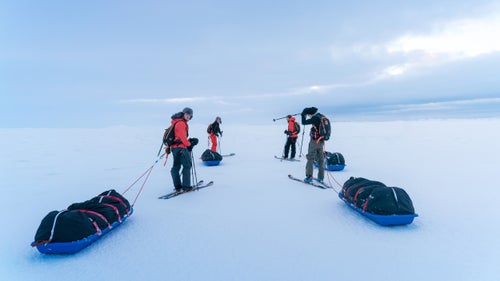
December 4: After being shuttled north, the team set out from the nation’s northernmost point, Rifstangi, dragging heavily laden pulks across a snowy plain. As the wind picked up and temperatures fell, Angus (far right), quietly fell ill.
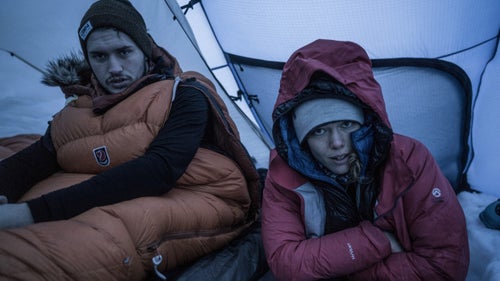
December 6: Within a few days of the team’s departure, Smith (left) received a call from Brandur warning them that Storm Desmond would make landfall the following day. The team, including Rees (right) hurried to build snow walls and secure the tent. Dowie was suffering from a lung infection, and the team arranged for a rescue. ICE-SAR transported Dowie by snowmachine to the coastal town of K├│pasker while the rest of the team followed on skis. The dream of an unsupported crossing ended with the extraction, but the three who remained—Wilson, Smith, and Rijnbeek—were still determined to cross Iceland from north to south. Dowie soon left for England and several days later Rees returned to the U.S.
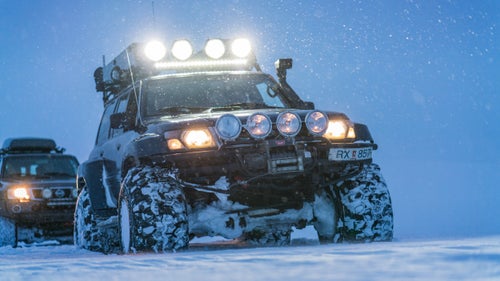
December 23: With his feet recovered after spending nearly five days at Hrauneyjar, Rijnbeek decided he was well enough to continue the tour. Meanwhile, Rees had returned to Iceland for the last leg of the expedition, this time with Renan Ozturk. The five hired two Nissan Pilots (pictured) to transport them from Hrauneyjar to Landmannalauger, a popular summer tourist area famous for its hot pools.
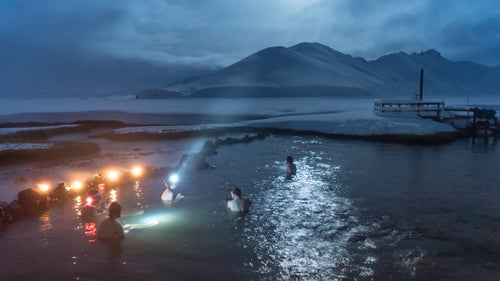
December 23: The team soaked in Landmannalauger’s geothermal lake, warmed their vacuum-packed meals in the water, and exchanged holiday gifts.
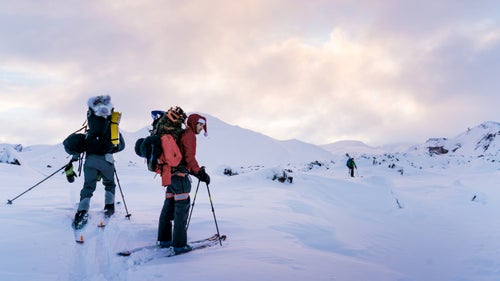
December 24: The day dawned cold and crisp. Wilson and Ozturk skinned up the craggy Laugahraun lava fields above Landmannalauger lugging 80-pound packs. They set out to follow the Laugavegur Trail, a north/south-trending tour through the highlands. The trek, which is popular with summer backpackers, links a series of backcountry huts.
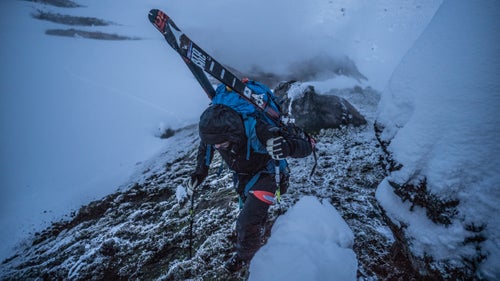
December 24: Smith following the popular Laugavegur trekking trail, weaving through ridges and moss-laden rock gardens warmed by the steam vents. The team chose lightweight, mid-fat backcountry boards (78mm waist) to handle the technical terrain on their original route. Post-expedition, a prominent member of the Icelandic Alpine Club criticized the choice; a skinnier ski, he said, would have allowed the team to move faster. Smith insists that the fatter skis were perfect.
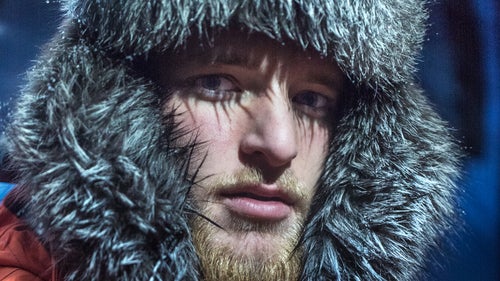
December 24: Stefan Rijnbeek was the first to rise each morning to make breakfast for the team. He was the last to turn in, too, because he melted snow for his friends’ water bottles. Rees called him the group’s den mother. Ozturk wrote, “Stef is only 20 but wise beyond his years in terms of technical and medical know-how and in his ability to harness optimism in the face of huge obstacles.”
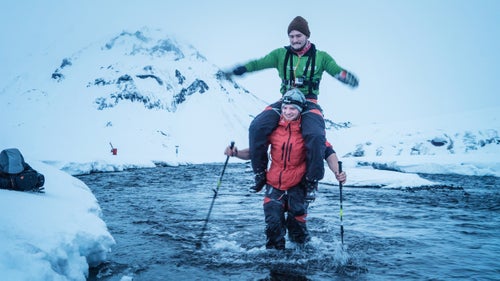
December 28: Rijnbeek (in red) wore waterproof-breathable boots rated to -90╦ÜC to ferry members and their equipment across the river Bl├ífjallakv├şsl. Rijnbeek made the trip at least 10 times, and saved Smith (in green) for last. Smith said he was courting disaster by riding on Rijnbeek’s shoulders rather than on his back, but he said it was important to inject some levity into the trip.
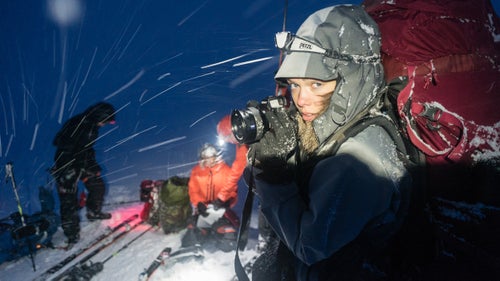
December 28: At about 2 p.m., another front moved in and the team was bedeviled by dry snow clumping onto damp skins. Here they strip skins from skis for the last time after they discovered the bases gripped the snow without them. Rees said she was exhilarated by the trips many challenges—including the difficulty of shooting in such trying conditions.